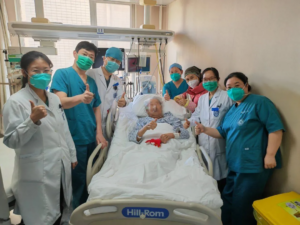
“Long new crown” affects more than 65 million people! 7 symptoms of each conditioning methods
In the three years since the New Crown pandemic, there have been increasing reports of New Crown worldwide, and some of the symptoms have been widely reported, such as fatigue, difficulty breathing, chest pain, and brain fog. A recent study by researchers at the University of Missouri, published in the Open Forum on Infectious Diseases, says that while a large number of symptoms have previously been reported to be associated with “new crowns,” this is not the case. The researchers looked at data from 17,487 patients at 122 health care facilities in the United States and selected the 47 most commonly reported symptoms of “long new crowns” to compare with common viral respiratory infections. The results showed that only seven symptoms were associated with “new crown” within 30-365 days after the encounter: rapid heartbeat, hair loss, fatigue, chest pain, shortness of breath, joint pain, and obesity.

What is “New crown”? The World Health Organization (WHO) refers to “neoconiosis” as “prolonged symptoms of neoconiosis”, which usually occurs within 3 months of onset, with symptoms and effects lasting for at least 2 months, and cannot be explained by any other diagnosis. The condition can last for weeks, months or even years, especially in patients with severe disease. Some studies have found that at least 65 million people worldwide are affected by “long new crowns,” and since many are not documented, the true number may be higher.
Liu Qiangui, chief physician of the Department of Respiratory Medicine at Beijing Geriatric Hospital, told the Global Times Health Client that there are a large number of “yangkang” patients in the clinic, and most of them are moving from the acute infection phase to the chronic recovery phase, complaining of many more symptoms than these seven. In view of the fact that our understanding of the new coronavirus is still incomplete, what exactly is the state of the “long new coronavirus” still needs to be continuously observed.
Why do Neovirus occur? There is a lot of speculation about the causes of “growing new crowns”, such as the accumulation of viral toxins; new coronavirus attacks multiple organ systems, causing microangiopathy and vascular endotheliopathy; immune dysregulation takes a long time to repair, etc. However, there is no need to worry too much, as a recent study published in the British Medical Journal showed that in people with mild neovirus infection (without hospitalization), most of the symptoms of “new coronary” can be improved within a year.
How can “new crown” be treated? Liu Qiangui said, among these symptoms, we need to pay great attention to the cardiovascular system-related symptoms, respiratory system-related symptoms, symptoms that have the risk of triggering an acute attack, such as the emergence of obvious chest tightness, wheezing, precordial pain, headache, dizziness and other symptoms to seek medical attention. In addition to maintaining a happy mood, optimism, adequate nutrition, and proper exercise in daily life, adjustments can be made in conjunction with traditional Chinese medicine adjunctive therapy.
Heart palpitations: rest is the key. If the heart beats too fast, the first thing to do is to take rest, get enough sleep, and strengthen your own nutrition by consuming more foods rich in protein and vitamins. If the heart beats continuously more than 100 times per minute or less than 60 times per minute, or if there are irregular beats, or even discomfort in the precordial region and palpitations, you need to be alert to cardiovascular-related diseases and prompt medical consultation is recommended.
Hair loss: No excessive intervention is needed. The hair growth cycle is 2~3 months, if there is no special trigger, the hair follicles will gradually enter a normal state and no special intervention is needed. During this period, it is best to wash your hair once every 2~3 days to keep your scalp clean and hair follicles healthy; avoid perming, hair dyeing and other behaviors that stimulate your scalp. If hair loss is still serious after 3 months, prompt medical consultation is recommended.
Fatigue: You can appropriately supplement Qi. Fatigue is the most common symptom of patients in recovery after “first recovery from a serious illness”. If the symptoms are mild and there is no respiratory distress, you can appropriately replenish qi, such as eating some lily, orris; you can also use Chinese medicine foot soak, take 3 slices of ginger, 5 grams of moxa, 5 grams of salt, boil for 10 minutes, add water to above the ankle joint, water temperature at 40~43 ℃, soak feet for about 30 minutes (heart disease patients need to reduce by half), once a day.

Chest pain: prompt medical attention is needed. Chest pain may indicate heart muscle damage, myocardial ischemia, etc. If symptoms are significant, prompt medical attention is required. Echocardiography, dynamic or static ECG and cardiac marker-related indicators can be applied to assess the presence of pericarditis, myocarditis or heart failure.
Shortness of breath: changes in body position are important. It is normal to experience shortness of breath (shortness of breath) during physical exercise, but shortness of breath after mild activity should be alarmed and the cause should be looked for. A CT chest examination can be performed to rule out pulmonary pathology, and a cardiovascular system-related examination can be performed to find the cause. If there is hypoxia (terminal oxygen saturation (SPO2 <93%) at rest), dyspnea is not relieved, and CT of the lungs suggests infectious lesions in the lungs, try prone position (lying flat with the abdomen facing down, lying prone) or forward leaning sitting position (sitting at the table, leaning forward above the waist, with the head and neck lying on the pillow and the arms on the table) to help relieve the symptoms of dyspnea.
Joint pain: internal plus external treatment. For joint pain or muscle and body pain, analgesics such as acetaminophen or ibuprofen can be taken; usually sufficient sleep should be guaranteed to help relieve pain; external Chinese medicine treatments such as hot compresses and gua sha can also be used.
Obesity: gradually resume exercise. On the basis of adequate nutrition and regular rest and rest, exercise can be resumed from low intensity, such as housework, walking and Badaanjin in the first week. If there is no obvious discomfort, the intensity can be increased in the second week, try brisk walking, going up and down stairs, tai chi, etc., so as to gradually return to the activity state before the disease and help heart and lung function recovery.


Average Rating